Analysis of Gaelic Football Sports Performance
Info: 10576 words (42 pages) Dissertation
Published: 20th Dec 2023
Tagged: Physical Education
Contents
Scenario
Introduction to GAA
Introduction to Client
Skill Related Component
- Flexibility
- Agility
- Balance
- Co-ordination
- Power
- Reaction time
Physical Fitness Requirements
- Cardiovascular fitness
- Muscular Endurance
- Muscular Strength
- Body Composition
- Flexibility
Fundamental Skills of Gaelic football
- Soloing
- Fist passing
- Kick passing
- Pick-up
- High Catch
Tactical Performance
Psychological Related Components
- Confidence
- Anxiety
- Overall Psychological Profile
Conclusion/Summary/References
Scenario
After completing assignment one in Analysis of Sports Performance, my coach has asked me to complete an in-depth analysis of my fellow sports club member Ryan.
The sport that my analysis will be completed on will be Gaelic football.
I will assess Ryan’s physical and skill-related components of fitness and his ability to execute the skills and techniques that are required in Gaelic football for an effective performance. I will also conduct assessments in regards to his the psychological profile which will give me a greater insight of what barriers Ryan Flanagan feels stand in his way psychologically.
Introduction to Gaelic Football
The GAA (Gaelic athletic association) is an organisation that is currently active in all 32 counties of Ireland and in a number of countries around the world such as America and England who have teams which compete in the all-Ireland competitions. The GAA was founded in the year 1884 in the Hayes Hotel. Since the formation of the GAA the headquarters has always been in Dublin, the current headquarters in situated at Croke Park which is the 3rd biggest stadium in Europe the current capacity for the grounds is 82,300. The GAA is the biggest organisation in Ireland but due to its amateur status it is currently unable to generate massive revenue therefore the GAA council often rent out the grounds to Ladies football, soccer, concerts and rugby.
A vast majority of the GAA at club level is voluntary which is inspiring to many as the GAA is pivotal in many communities Slaughtneil which is no bigger than 300 families but have had multiple wins in Ulster Championships this is a great story for the GAA as it shows the value of communities and how they are reserving the Gaelic cultures such as language, music, sport and poetry. There is currently over 2,200 clubs in Ireland alone this is a brilliant achievement for an amateur sport as players and coaches will have 9-5 jobs they must complete and then train 4 times a week a play matches it takes serious commitment for very little reward sometimes but the prize for every young Gael from a young age is the chance for someday to maybe hold the Sam Maguire winning with their county, family and communities.
There is a lot of similarities between GAA, soccer and rugby as they are all played outdoor on grass pitch which is measured at 145m x 90m by width. Like rugby the goal posts are high to accommodate the points. The ball used is round like a soccer ball but is known to be heavier.
Introduction to Client
Ryan (19) is a young sports student who is currently in his first year of HND. Ryan has played Gaelic with his local club Teemore for a number of years now he has a great interest in Gaelic football as he has been involved in the sport since a very young age, Ryan’s family has the view that Gaelic football is traditional to Ireland and their local community, it has been played by many of his family for generations before him.
Within a small community such as Teemore everyone is always involved with Gaelic from a young age let it be young kids playing Sunday morning football or elderly people down cheering on their local team. Ryan enjoys playing for his local junior side and has relished success throughout the years winning a number of trophies at underage level.
Ryan believes himself to be a reasonably good footballer and is confident in his ability he believes at the end of this year he should be making a push for a county u21 trial.
The reason why I have chosen Ryan for analysis is that I have played against him on a number of occasions and I believe he is a good candidate. Ryan has a lot of potential within the game and has an excellent skill set because he has a great ability of the skills of Gaelic football and I am keen to compare him to data to see if he is normal or above average.
Skill Related Component
There are a number of skill related components that are essential for the player to be fit to execute the correct techniques when playing Gaelic at a high level.
These skill related component are:
- Flexibility
- Agility
- Balance
- Co-ordination
- Power
- Reaction time
Flexibility
Flexibility is vital in every sport but I feel in Gaelic it is a key component as a lot of time a player can be bending down to pick up a ball or jumping up to catch a ball.
“Hamstring injuries are common in Gaelic football and have been associated with reduced flexibility in other sports.” (Clifford, 2012)
Within the last 5-10 years in the GAA they have tried massively to introduce increased flexibility, teams have started to introduce yoga classes and activate warm to every teams routine also you now see teams often having nights of stretching instead of training.
To test Ryan’s flexibility I will use the sit and reach test all that is required for this is a ruler and sit and reach box.
| Attempt 1 | Attempt 2 | Attempt 3 | Average |
| 13 | 15 | 15 | 14 |
The normative data for 16-19 year olds sourced from Brian Mac:
| Gender | Excellent | Above average | Average | Below average | Poor |
| Male | >14 | 14.0 – 11.0 | 10.9 – 7.0 | 6.9 – 4.0 | |
| Female | >15 | 15.0 – 12.0 | 11.9 – 7.0 | 6.9 – 4.0 |
(Davis et al, 2000)
After carrying out the first test Ryan believed he could achieve better if he had his legs supported so after this we supported his legs to allow him to bend more and as you can see it brought Ryan into the excellent category, I would recommend that Ryan carries on to stretch like he is currently doing and to ensure he does stretch daily to reduce the chance of injury.
Agility
One of the most vital skills in Gaelic in my opinion is agility as if a player has this quality the likely hood that they will increase their rate of beating opponent’s increases greatly or if it’s a defender it allows the player to recover and catch attackers before they score.
“Agility is the ability to change direction quickly and control the movement of the whole body. It is important that players develop the ability to move in a variety of directions, leading off both the left and right feet.” (Learn GAA, 2003)
To test the level of Ryan’s agility we used the Illinois agility test. To conduct this test all we needed was a non-slip surface, cones, measuring tape and timing gates.
To achieve accurate results we conducted this test 3 times, shown below;
| Attempt 1 | Attempt 2 | Attempt 3 | Average |
| 15.58 | 16.01 | 15.55 | 15.88 |
| Gender | Excellent | Above Average | Average | Below Average | Poor |
| Male | 15.2 – 16.1 secs | 16.2 – 18.1 secs | 18.2 – 19.3 secs | >19.3 secs | |
| Female | 17.0 – 17.9 secs | 18.0 – 21.7 secs | 21.8 – 23.0 secs | >23.0 secs |
The normative data for 16 to 19 year olds completing the Illinois agility test:
(Davis et al, 2000)
Ryan scored above average in this test which is good I would recommend Ryan to constantly train his agility by completing at least 2 agility session a week. Some ideas for Ryan to include into his sessions are turns, stop starts, jumps and sprints etc. during the testing I recorded some data for Ryan if he wishes to improve this he must continue with the recommendations above.
|
Balance
When competing in any sport balance is important as it ensures the player is kept in an upright position and is able to maintain stability.
“Balance is the ability to maintain a stable orientation in relation to the immediate environment. Developing good balance skills is important in Gaelic games as players are often required to perform the skills while off balance or while balanced on one foot.” (Learn GAA, 2003)
Gaelic football requires balance to ensure the player first can stand stable on two feet without falling over, changing direction, picking the ball of the ground, shooting and passing also having to change foot and kick with their weaker foot this can send anyone of balance as they might not be used to the mechanics.
To test Ryan’s balance I used the stork test. The equipment used was a flat non slip surface and a stop watch.
| Attempt 1 | Attempt 2 | Attempt 3 | Average |
| L: 82 | L:81 | L:83 | 82 |
This is the normative for the young male between the ages 16-19 from Brian Mac Sports
| Excellent | Above Average | Average | Below Average | Poor | |
| Males | >50 | 41-50 | 31-40 | 20-30 | |
| Females | >30 | 23-30 | 16-22 | 10-15 |
(Johnson & Nelson 1979)
After conducting the tests, Ryan has scored an average of 82 seconds this means Ryan is in the excellent category according to the normative data. To ensure that Ryan maintains his excellent rating I recommend that he continues to squat and even add in one legged exercises such as squatting and stretching.
Co-ordination
Co-ordination is the link between a numbers of skills, co-ordination is impossible to have without a good level of balance.
“Coordination is the ability to move different parts of the body simultaneously or in sequence in order to perform a specific task. Gaelic games require a good sense of Coordination as players are required to perform skills that involve hand-eye coordination, hand-foot coordination and foot-eye coordination at various stages.” (Learn GAA, 2003)
Gaelic football requires great co-ordination and it is essential, in the Gaelic games on the pitch there is many movements that need to execute perfectly on the right time. Without a good level of co-ordination is the fundamental skills such as soloing would be impossible as it requires running and kicking the ball to yourself at the same time.
To test Ryan’s co-ordination I used the Alternate Hand Wall Toss. The equipment required to complete this test is a tennis ball, measuring tape, stopwatch and a flat surface with a flat wall also.
Ryan’s final results are showing below:
| Attempt 1 | Attempt 2 | Attempt 3 | Average |
| 34 | 35 | 36 | 35 |
The normative data taken from Brian Mac Sport:
| Age | Excellent | Above Average | Average | Below Average | Poor |
| 15-16 years | >35 | 30 – 35 | 25 – 29 | 20 – 24 |
(Beashel and Taylor, 1997)
After conducting the test, Ryan scored an average of 35 catches in (30 seconds). Based on the normative data Ryan has scored in the excellent category this is good as it means he has an edge on his opponents. To ensure that Ryan keeps his excellent status I would recommend that Ryan trains his co-ordination by throwing a ball against a wall or even to do this with a friend.
Power
Power is the force applied when breaking a tackle or the strike of the ball when kicking it.
“The ability to exert a maximal force in as short a time as possible, as in accelerating, jumping and throwing implements.” (Top End Sports, 2015)
In Gaelic power was important as the purpose to win the game is by scoring more points and goals than the opposite team. Power is used to break tackles, win the ball in the air, kick and shoulder opposite players.
For this test I have decided to use the 30 metre sprint test, this test requires measuring tape, timing gates and cones.
| Attempt 1 | Attempt 2 | Attempt 3 | Average |
| 4.4 | 4.4 | 4.3 | 4.4 |
The normative data for young males aged 16-19 years old taken from Brian Mac Sports:
| Gender | Excellent | Above Average | Average | Below Average | Poor |
| Male | 4.0 – 4.2 | 4.3 – 4.4 | 4.5 – 4.6 | >4.6 | |
| Female | 4.5 – 4.6 | 4.7 – 4.8 | 4.9 – 5.0 | >5.0 |
(Davis, 2000)
After completing the test we have got Ryan’s results and he has scored an average of 4.4 this means that he is ranked in the average category. If Ryan wanted to improve his power score I would recommend that he introduces some power training by doing short sharp burst sprints, squats and jumping these are great ways to build power but also when squatting to use weights to help upper body power.
Reaction time
Reaction time is vital as it often means the person with the better reactions is the person to win the ball in Gaelic football.
“Reaction time is the ability to respond quickly to a stimulus. It important in many sports and day to day activities, though it is not often measured. Simple reaction time is the time taken between a stimulus and movement.” (Top end sports, 2015)
In Gaelic football reaction time is important, you must be able to react to a breaking ball or have good reactions to beat an opponent to a ball. A goalkeeper must have greater reaction times because they must be able to stop the ball and react to the player striking it at goal.
For this test I shall use the ruler test. All that is required is a flat surface and a ruler.
| Attempt 1 | Attempt 2 | Attempt 3 | Average |
| R:18 | R:18 | R:18 | 18 |
Based on the normative data for 16-19 year olds from Brian Mac Sports.
| Excellent | Above Average | Average | Below Average | Poor |
| 7.5 – 15.9cm | 15.9 – 20.4cm | 20.4 – 28cm | >28cm |
(Davis, 2000)
After conducting the test on Ryan we have come back with the average score of 18cm in the ruler test. Using the normative data Ryan has scored in the average category, if Ryan wishes to hold this score or even improve it I would recommend that he download a reaction app on his iPad.
Physical Fitness Requirements
There are a number of physical fitness requirements that are vital for the player to be fit to execute the correct techniques when playing Gaelic Football at a high level.
These physical fitness requirements are:
- Cardiovascular fitness
- Muscular Endurance
- Muscular Strength
- Body Composition
- Flexibility
Cardiovascular Fitness
Cardiovascular fitness is vital in Gaelic football as it involves a lot of running so if a person has a greater level of cardio fitness they are more likely to recover quicker after sprints or other cardio related events.
“Cardiovascular endurance, aerobic fitness, or stamina, is the ability to exercise continuously for extended periods without tiring.” (Top end sports, 2015)
In Gaelic football it’s important that a player shows good cardiovascular fitness as usually the faster player will come out on top as he will have an edge on his opponent on winning the ball.
Result |
| 2500m |
To test Ryan’s cardiovascular fitness I will use the Copper 12 minute run, the equipment required is a running track and stop watch.
The normative data taken from Brian Mac Sports.
| Age | Excellent | Above Average | Average | Below Average | Poor |
| 13-14 | >2700m | 2400-2700m | 2200-2399m | 2100-2199m | |
| 15-16 | >2800m | 2500-2800m | 2300-2499m | 2200-2299m | |
| 17-19 | >3000m | 2700-3000m | 2500-2699m | 2300-2499m | |
| 20-29 | >2800m | 2400-2800m | 2200-2399m | 1600-2199m | |
| 30-39 | >2700m | 2300-2700m | 1900-2299m | 1500-1999m | |
| 40-49 | >2500m | 2100-2500m | 1700-2099m | 1400-1699m | |
| >50 | >2400m | 2000-2400m | 1600-1999m | 1300-1599m |
(Cooper, 1968)
After carrying out the copper test Ryan has compared to an average male aged 17-19 with a result of 2500m. I feel Ryan can improve these results to better his ability on the Gaelic field by training extra outside of the team sessions 2 or 3 nights a week doing exercises such as jogging or hill sprints also another great training exercise for this is running with ankle weights.
Muscular Endurance
Muscular endurance is vital as it’s the ability for a player to perform during a game with minimal fatigue.
“Muscular endurance is the ability of a muscle or group of muscles to sustain repeated contractions against a resistance for an extended period of time. It is one of the components of muscular fitness, along with muscular strength and power.” (Elizabeth Queen, 2017)
In Gaelic A game will last 70 minutes this means that players must have great cardiovascular endurance because within a game a player must solo, run, shoot and tackle and a lot of this is done in high pressure situations.
To test Ryan’s muscular endurance I used the 3 minute step up test, the equipment required was flat surface, a step and stopwatch.
| Attempt 1 | Attempt 2 | Attempt 3 | Average |
| 108 | 108 | 106 | 107 |
Based on the normative data for males aged 18-25 years old from Brian Mac Sports.
| Age | 18-25 | 26-35 | 36-45 | 46-55 | 56-65 | 65+ |
| Excellent | ||||||
| Good | 79-89 | 81-89 | 83-96 | 87-97 | 86-97 | 88-96 |
| Above Average | 90-99 | 90-99 | 97-103 | 98-105 | 98-103 | 97-103 |
| Average | 100-105 | 100-107 | 104-112 | 106-116 | 104-112 | 104-113 |
| Below Average | 106-116 | 108-117 | 113-119 | 117-122 | 113-120 | 114-120 |
| Poor | 117-128 | 118-128 | 120-130 | 123-132 | 121-129 | 121-130 |
| Very Poor | >128 | >128 | >130 | >132 | >129 | >130 |
(Canadian Public Health Association, 1986)
After conducting the test for Ryan’s average heart rate we have got the result of 107bpm this leaves Ryan in the below average category but Ryan has stated before the test he drank an excessive amount of caffeine which is incline to increase his heart rate. Ryan should improve on this by doing more endurance related exercises such as weight rooms, hill sprints and body weight exercises 3 or 4 times a week on top of his Gaelic training.
Muscular Strength
Muscular strength is important because players must hold of the opposition when they have possession of the ball they must also shoulder them in an attempt to win the ball back.
“Muscular strength refers to the amount of force a muscle can produce with a single maximal effort. Muscle strength is measured during muscular contraction.” (Jennifer Scott, 2017)
Gaelic is a very physical sport players often hit big collisions with shoulder tackles because of this muscular strength is vital a player with weak muscular strength is very likely to be hurt or knocked over. Also muscular strength is important for in the air battles as it helps players hold off opponents.
To test Ryan’s Muscular strength I used the grip strength test, the equipment required for this is a hand grip dynamometer.
| Attempt 1 | Attempt 2 | Attempt 3 | Average |
| L:32 R:28 | L:31 R:30 | L:31 R:31 | L:31 R:30 |
The normative data for 16-19 year old males taken from Brian Mac Sports
| Gender | Excellent | Good | Average | Fair | Poor |
| Male | >56 | 51-56 | 45-50 | 39-44 | |
| Female | >36 | 31-36 | 25-30 | 19-24 |
(Davis, 2000)
After conducting the tests and analysing the results Ryan falls into the weak bracket. This shows that Ryan must train his muscular strength as its vital now more than ever as Ryan is starting to break into the Adult Teams he will come up against men whole will be very physical. I recommend Ryan to start weight training with night weights in high reps 3 or 4 nights a week for an hour and eat the correct foods also use products such as protein and creatine to increase mass after a workout but as it becomes easier to increase the weight also and lower reps.
Body Composition
Body composition can vary in sport a lot of midfielders are tall and strong or you have a keeper who might be less muscular but weigh more.
Three types of body composition:
- Endomorph
- Mesomorph
- Ectomorph
To test Ryan’s body composition by measuring his fat I will be using the Jackson and Pollock Skinfold Test, the equipment required was skinfold callipers.
| Result |
| 15.1% |
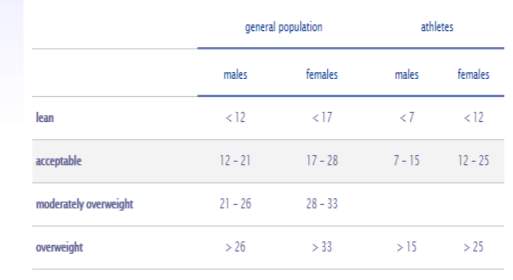 Normative data taken from top end sports.
Normative data taken from top end sports.
After conducting a skinfold test on Ryan I can see he falls into the acceptable category for body composition for both general and athlete population, I feel this is because the excessive amount of training Ryan does for Gaelic it has helped him to tone this.
Fundamental Skills of Gaelic football
Gaelic football is described as a very technical game as there are a number skills that players need to be perfect to be fit to play at the highest level. These skills are learned from a young age and progress and perfected through underage training and games right up to senior and junior level were players are still working on these key fundamental skills to ensure they remain at a high level.
The skills that I will analysis are:
- Soloing
- Fist passing
- Kick passing
- High Catch
For this part of my analysis I used photographs and video to document Ryan completing the skills through the three different stages:
- Preparation
- Execution
- Recovery
Soloing
In Gaelic football you must solo or bounce the ball after every four steps or the referee will blow the player for over carrying the ball. The technique of soloing the ball is:
- Release the ball from the dominant hand onto the dominant foot.
- Ensure the leg is in a straight position
- Keep your eye on the ball (with practice players will be able to solo without looking)
- Flick the ball with the tip of the toe into the hands make sure the foot is tipped upwards otherwise the ball will roll on.
Preparation
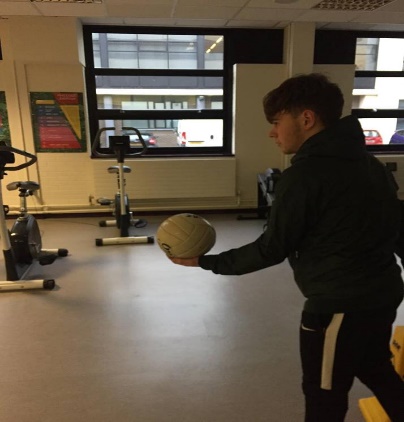
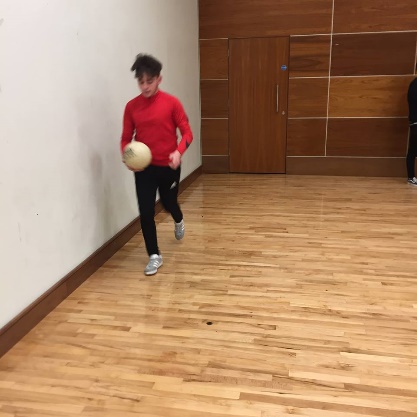
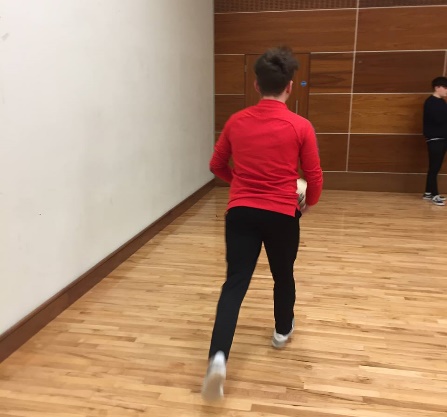
Side view
Frontal view
Behind view
During the preparation stages Ryan is attempting to drop the ball from his dominant hand on to his dominant foot.

When comparing Ryan’s preparation stages to the elite athlete it shows a lot of similarity Ryan and the professional both dropped the ball of their dominate hand. They both drop the ball perfectly on to their foot not having to break stride.
Execution
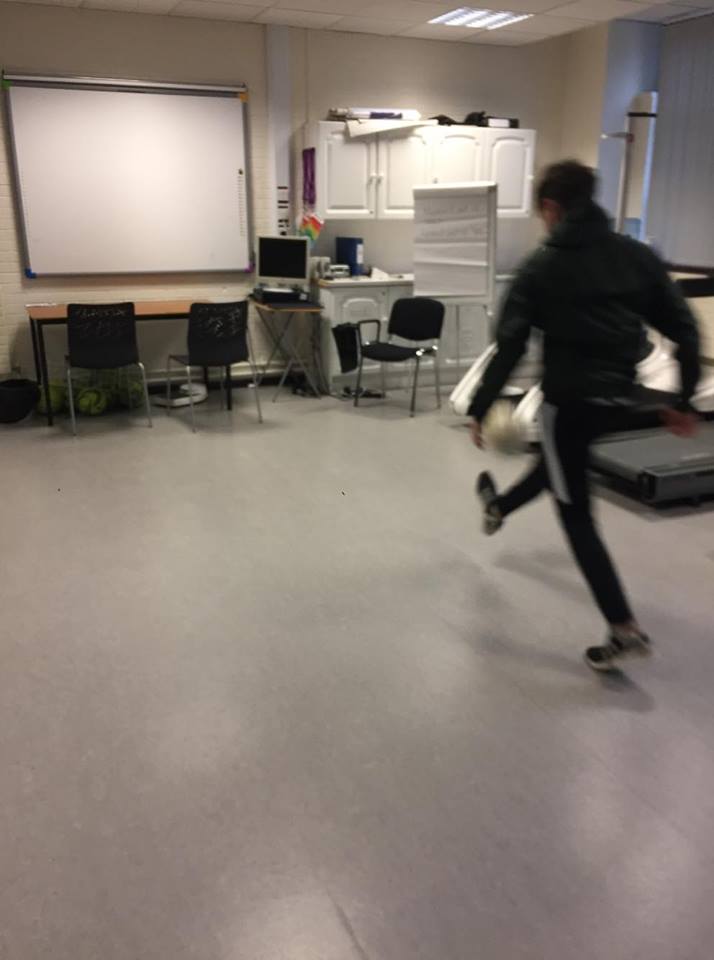
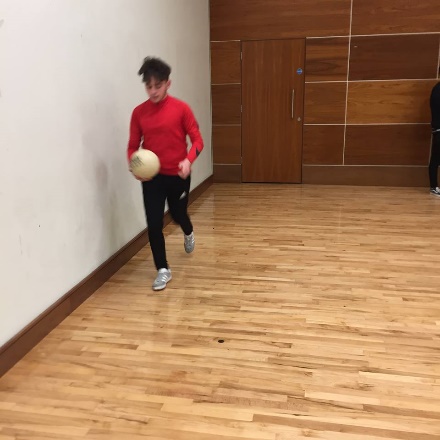
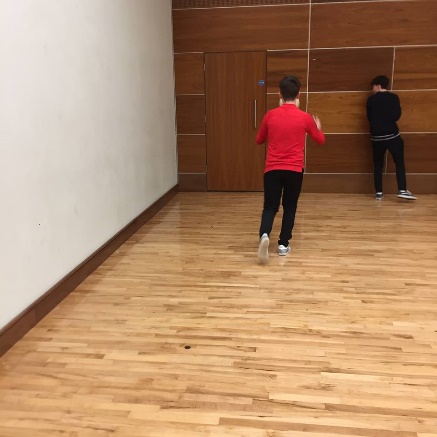
Behind view
Frontal view
Side view
During the execution stage Ryan, has dropped the ball onto his foot and the connection with the toe and ball is being made. The ball will hit the toe to make a flicking action back into the hands of Ryan.
From the footage taken I can see Ryan has great technique his eyes are constantly on the ball, he keeps a straight leg when making the connection.
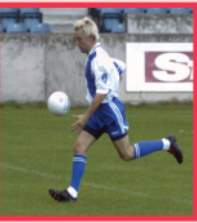
When I make the comparison between Ryan and the professional there is multiple similarities such as straight leg, eyes on the ball and the toe is turned up to ensure the correct connection is made. The hands are also in the correct positon to collect the ball on the upward motion. This shows me that Ryan has mastered this skill to a sufficient level to attempt it in a match situation.
Recovery
In the recovery stage of this action is when the player has executed the move and the ball is back in their possession.

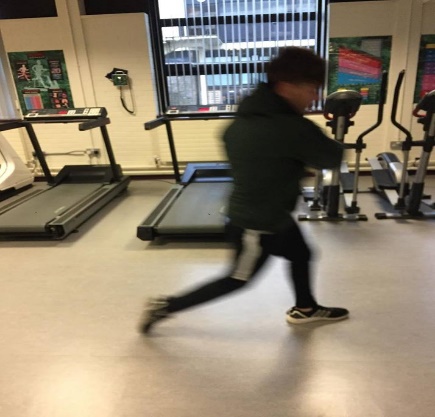
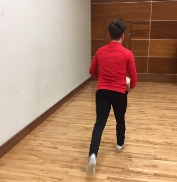
Side view
Behind view
Frontal view
In this stage the ball should be in Ryan’s hands as shown above and the player must have the ball secured in both hands and be able to receive a tackle or shoulder without spilling possession. In the pictures shown above you can see Ryan has the ball gathered into his hands and secured tightly this is the correct way that every young footballer will be taught from a young age.
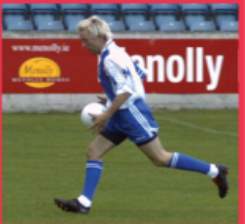
When I now compare Ryan and the professional for the recovery stage I yet again see several similarities such as they both keep their eyes on the ball always. Ryan and the professional have both secured the ball in both hands this is good practice because it means the possession is harder to overturn for the opposition.
Fist Passing
The fist pass is a very useful skill in Gaelic it can be used to both pass the ball or score a point in a match play situation. In the modern day Gaelic the fist pass is becoming incredibly more used as stats have started to show it’s the most used method of passing as it can be done in small spaces and is quicker than a kick pass over a short distance.
The fist pass technique:
- The player holds the ball on his hand and closes his other hand into a fist.
- The player strikes the ball with a closes fist.
- To ensure the pass is accurate make sure you follow through the ball.
Preparation


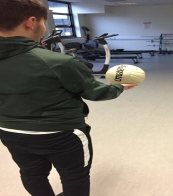
Behind view
Frontal view
Side view
In the preparation stage Ryan is exhibiting the correct technique, he has the ball placed on his hand and can take a full swing at the ball he has his eyes on the ball to ensure he connects in the correct spot.

Comparing the stages of this you can see some similarities between Ryan and the professional such as they both have their eyes focused on the ball and the ball is well spaced from the body to ensure that Ryan can get a good connection.
Execution
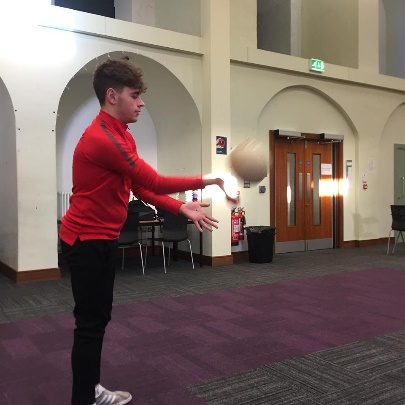
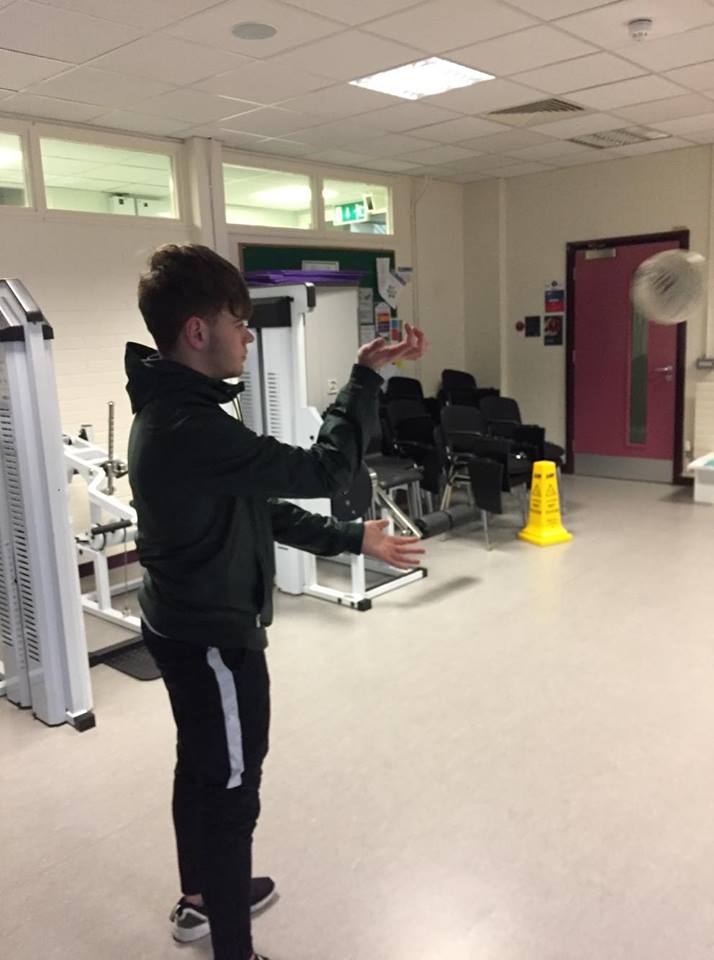

Side view
Behind view
Frontal view
Ryan can be seen bringing his hand up to the ball and following through as it’s the most accurate method. The pictures show Ryan uses the correct technique as his hand follows the ball through in a striking motion. With his eyes out infront of him looking where the ball is going.
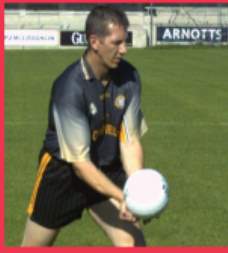
When comparing Ryan and the professional I can see a great amount of similarities with the pictures with their legs shoulder width apart with their eyes facing forward at the intended target. This gives the indication that Ryan has a very high ability in this fundamental skill.
Recovery
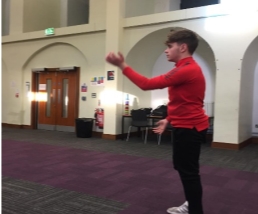
Ryan shows the correct technique as he follows through with his strike with his feet planted in the ground to ensure that he is stable and sturdy. There is power behind the pass this is good as it ensures the pass is zippy and accurate.
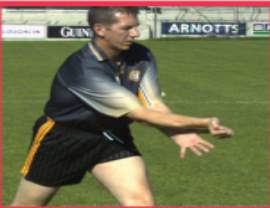
Kick Pass
The kick pass is used in Gaelic for a ball that will be passed outside of fist pass range or it can also be used tactically to put the ball on top of the full forward in the box. The kick pass is used to restart the play in Gaelic from a free kick, side-line ball or goal kick.
The kick pass technique:
- Release the ball from the dominant hand to the dominant foot
- Keep toe and foot straight
- Strike the ball and follow through the ball.
- Ensure the head is lifted to watch the ball travel and you can’t be blocked down
Preparation
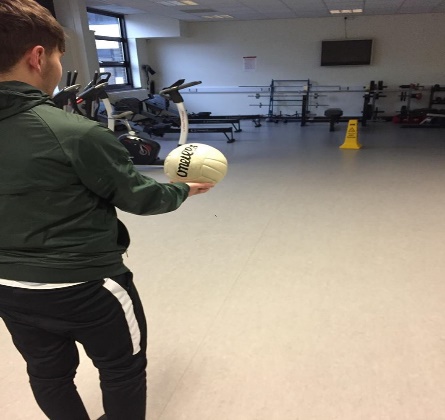
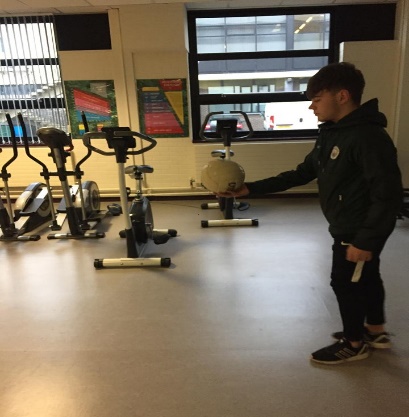
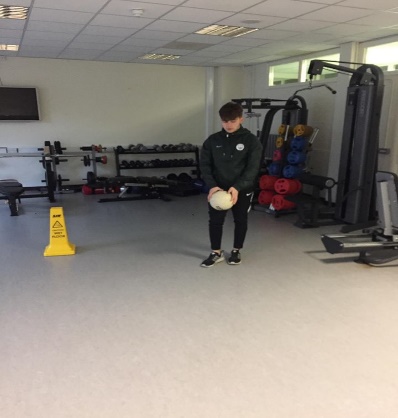
Behind view
Side view
Frontal view
In the preparation stage Ryan is getting ready to drop the ball from his dominant hand onto his dominant foot. These pictures show that Ryan is fully focused on the ball and has the proper eye contact.
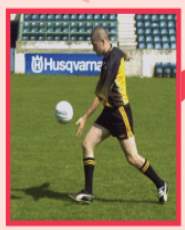
During the preparation stages you can see both Ryan and the professional both keep their eyes firmly on the ball when dropping it. One bit of critical analyse I have for ryan is that his stance is very narrow and can make his easy to toss over.
Execution
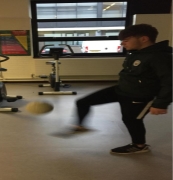
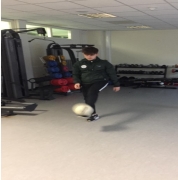
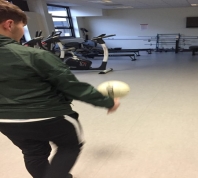
Side view
Behind view
Frontal view
In the execution of this kick pass Ryan has his eyes firmly fixed on the ball and is striking the ball with his laces which is the correct technique as many try to strike with the inside of their foot which is inaccurate and will cover less distance. Ryan’s stance is very statue like as his hands are down by his side and his feet are very close together.
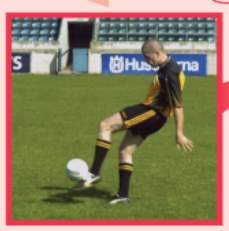
When I compare both Ryan and the professional both them have their head down when striking the ball to ensure the correct connection is made. Both are kicking the ball with their laces which shows good technique. I would recommend that Ryan practices his stance more to ensure he perfects his technique.
Recovery
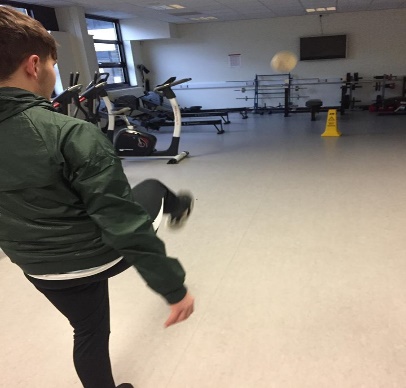
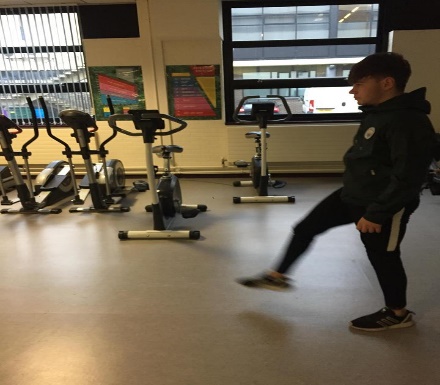
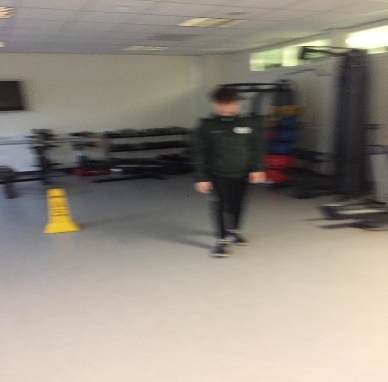
Frontal view
Behind view
Side view
In the recovery stage of the kick pass you can see Ryan has his leg extended after following through his kick, Ryan also has his eyes fixed in front of him after kicking to ensure the ball has met the target. Ryan is very narrow in his stance still which I wound recommend he improved.

Comparing both Ryan and the professional there is similarities in the kick pass such as follow through and not only following through with the kick but also the head will rise when the ball has been struck. I would recommend using an arm for balance when kicking the ball to increase the accuracy of the kick.
High Catch
The high catch is a skill that is used tactically in Gaelic in a number of positions such as midfield during a kick out for ‘the mark.’
When a player catches the ball cleanly from a Kick-Out without it touching the ground, on or past the 45m line nearest the Kick-Out point, he shall be awarded a ‘Mark’ by the Referee. (GAA, 2017)
Teams will also use the high catch tactically in the full forward line when they have a physical forward they will punt the ball in on top of the forward to win the aerial battle.
The technique for the high catch is:
- Watch the ball and judge the jump
- Move forward and use the dominant foot to leap
- Pull legs and arms upwards for power
- Make W shape with hands
- Draw the ball into chest when in possession
Preparation
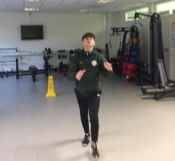
Frontal view
Ryan has his eyes firmly fixed on the ball he moves his body forward with the dominate leg behind to be used as a driving force when jumping. His arms are extended ready to be uses as a leaver when jumping.
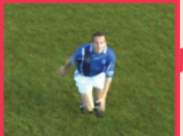
When comparing Ryan against the professional it’s like a mirror photo both have prepared in the exact same way eyes fixed on the ball body positioning forward and arms up. Ryan has mastered the preparation stage of the high catch.
Execution
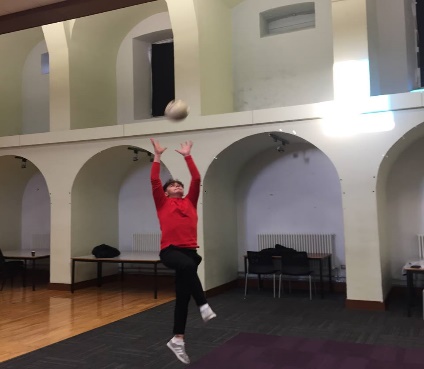
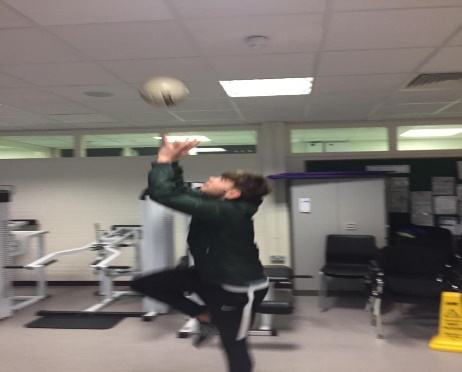

Frontal view
Behind view
Side view
In the execution stage Ryan has his eyes fixed on the ball his hands are coming together correctly to win the ball, Ryan is using his knees to drive up and increase the height in his jump and this is also used to block other players getting close to compete for the ball.

When comparing both Ryan and the professional they both have their eyes firmly fixed on the ball and the path its taking with their arms extended in front of them to win the ball. The professional and Ryan both use their knee as a driving force up. Ryan has mastered the high catch and can perform this well in a match situation as it can often be hard to perfect.
Recovery
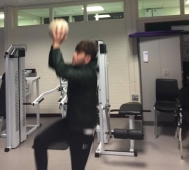
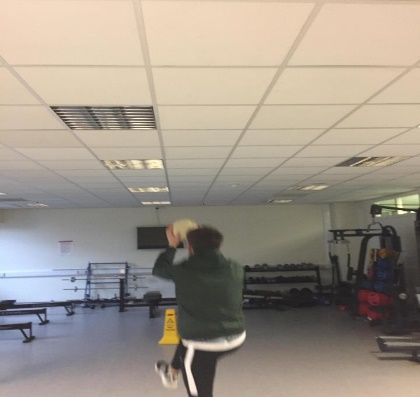
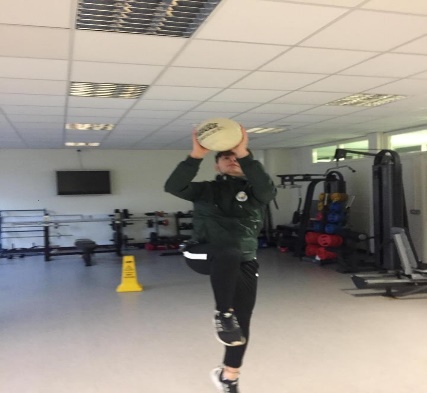
Frontal view
Beside view
Behind view
In the recovery stage Ryan has won the ball and is taking it down into his body to secure possession to protect it from the opposition.
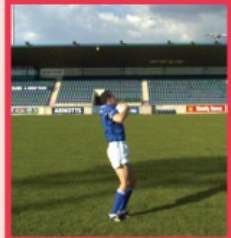
When comparing the recovery stages there is a difference as the professional has caught the ball into his chest rather than above the head but both Ryan and the professional collect the ball into their chest.
Tactical Performance
Gaelic football is played with 15 players on each team with a standard layout of 1GK, 6 defenders, 2 midfielders and 6 forwards. Some managers are known for adapting this layout to add sweepers and other tactical roles.
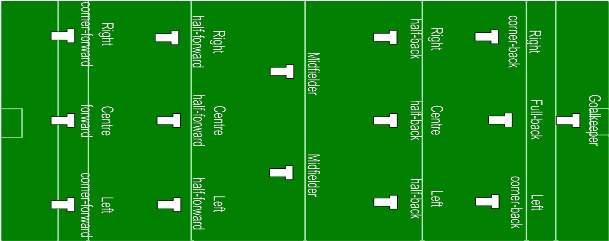
After analysing Ryan’s results relating to skill components, physical fitness and fundamental skills I believe he would be best suited to the wing half forward position as he has excellent agility, co-ordination, flexibility and reaction time which are all key components of a good wing half forward to get into scoring situations.
Ryan’s weaknesses are muscular strength, cardiovascular fitness and power due to this its best to keep Ryan out of positions such as defence or midfield that require these components.
Psychological Related Components
In sport nowadays there is a greater emphases on psychological aspects that can affect a players training, game and preparation coming up to events.
I asked your Ryan to complete a number of questionnaire looking at confidence, anxiety and his overall psychological profile.
Confidence
What is Confidence?
“The belief that you can successfully perform a desired behaviour” (Weinberg and Gould, 2015)
Trait Sport Confidence Inventory, this test consisted of three questions:
- Compare your confidence in your ability
Low Medium High
1 2 3 4 5 6 7 8 9
to execute the skills necessary to be successful to the most confident you know
- Compare the confidence you feel right
Low Medium High
1 2 3 4 5 6 7 8 9
now in your ability to perform underpressure with that of the most confident athlete you know
- Compare your confidence in your ability
Low Medium High
1 2 3 4 5 6 7 8 9
to concentrate well enough to be successful with that of the most confident athlete you know
Based on Ryan’s results I’d say that he is a fairly confident person on the football pitch and believes in his ability. I believe this is a good approach to have as it can mean he won’t shy away from opportunities in big games or crumble under pressure in match situations. But with Ryan’s high level of confidence comes risk too as Ryan might over estimate his ability and try to do things on his own.
Anxiety
“Anxiety is a negative emotional state characterised by nervousness, worry and apprehension and associated with activation or arousal of the body” (Weinberg and Gould, 2015)
Sport Competition Anxiety Test (SCAT)
To measure Ryan’s level of anxiety I asked him to complete a Sport Competition Anxiety Test (SCAT).
Ryan scored 17 in the SCAT based on normative data that means Ryan has normal levels of anxiety for a young athlete.
This is a good thing as anxiety can cripple a player in a big game and cause them to play bad or not be able to reach their full potential on the pitch, in years to come when Ryan gathers experience on the pitch he is more likely to suffer less anxiety even more and being on the football pitch will be second nature.
Overall Psychological Profile
To establish a better understanding of Ryan’s psychological profile I have asked him to complete a psychological questionnaire, this will help me get a deeper understanding of his psychological prolife, goal setting, motivation, confidence, pain management, arousal and mental imagery.
In sport psychological factors are just as important as physical factors as Gaelic is played in your head but your body is your tools.
Goal setting is very important as it shows progress, some players make the mistake of setting one goal for a year but realistically they should be setting 3 at the start of the season a short term goal, mid-way goal and finally the overall goal. A short term goal could be something like score 2 goals in the first 5 games of the season when then you have a mid-way goal of maybe scoring 10 points in the first 10 games and a final goal of reaching a final.
A goal Ryan set was to score 6 points in every game, Ryan managed to do this 15 times in the league which is a remarkable achievement this can be good because it will give Ryan confidence in his ability.
Motivation is something every great player ever to step out on a field must have and no player is an acceptation to this. Every player must give 100% for themselves but more importantly their teammates as on a team sport you are fighting for your friends and family and you must be ready to give that extra 10% when required. Ryan score a total of 22 this shows he is extremely motivated as he falls into the excellent category when compared to the normative data.
Confidence is critical for forwards as they must believe they will score or beat their man with skills or their pace. Ryan scored 23 in this which means he falls into the excellent category. Ryan is a very confident young man off the pitch and when he steps on the pitch it transfers over with him I’ve seen a lot of young men with confidence in abundance but when they step on the pitch they crumble. It shows Ryan can perform in pressure situations and will do at a high standard when required.
Pain management is how a player will take a knock for his team and continue to struggle on when he isn’t at 100% fitness and he will lay his body on the line for the better of the team, this can have a major moral boost also when players see others sacrificing their body it can drive the team to win and inspire. Ryan scored 17 in this which I believe is good because it shows he will give everything for his team when it’s required of him.
Arousal is about the players preparation on how ready they are mental and physically for a match, arousal can be both positive and negative to a player it depends on factors such as a players personality, stress levels and mood. Ryan has scored 15 this means he falls into the average category Ryan has told me he uses music, gaming and breathing techniques to help him deal with arousal.
Mental visualisation is how a player pictures themselves in match situations under pressure such as free taking or penalty taking. An example of good use of mental visualisation is the player will pick the ball up and take 3 deep breathes and exhale and slot the ball over the bar or at the other end of the pitch a player will visualise themselves blocking a ball or delivering a massive hit on a man. Mental readiness is very important and even on the same level as being physically ready for a game. In this section Ryan has scored 20 which is great. This shows Ryan goes into every game with a clear game plan and has the ability to set aside negativity before a match.
Conclusion/Summary
After fully completing this analyse of Ryan’s performance with the physical and skill related components of fitness, his ability to produce the skills and techniques of Gaelic and evaluating his psychological profile I have now came to the conclusion that Ryan has a great ability in Gaelic football mentally and physically.
Now I will summarise Ryan’s strengths and weaknesses to give him a plan so he can work and improve his ability when he gets back out for the start of the season.
| Strengths | Weaknesses |
| Agility- Ryan has achieved excellent on this test I would recommend that Ryan completes agility training 2 or 3 times a week such as speed ladders or running with sharp direction changes. | Power – I believe Ryan can do a lot of work for this because this is an area where he seems to be lacking. Ryan should introduce sharp short sprinting, weighted squats and weighted running. |
| Flexibility – to maintain his level of flexibility I recommend that Ryan has a foam rolling session after he trains and on his days off to keep his muscles loose. | Reaction time – Ryan has scored average in this but I believe this is a critical component and I would recommend working on it. |
| Balance – for Ryan to keep his level of balance I would recommend that he introduces single legged squats into his work out and lunges. | Cardiovascular fitness – Gaelic is very physically demanding and I would recommend that Ryan trains this to help with his overall fitness maybe by introducing more cardio related exercises. |
| Co-ordination – Ryan has scored an excellent compared to the normative data but to ensure he keeps his co-ordination at this level he can do a simple drill just of throwing a ball against a wall and catching it. | Muscular endurance – Ryan has scored poorly in this and I would recommend that his trainings this regularly to improve this by circuit classes or cross fit training. |
| Arousal – Ryan deals well with arousal and im confident he can improve this as he comes more accustom to playing at a higher level of football. | Muscular strength – I recommend Ryan to start weight training with night weights in high reps 3 or 4 nights a week for an hour and eat the correct foods also use products such as protein and creatine to increase mass after a workout but as it becomes easier to increase the weight also and lower reps. |
| Motivation – Ryan his highly motivated when he steps out on the pitch he leaves everything on it he is a great team player and will give 100%. | Kick passing – Ryan performed well in the kick pass but if I had to critically analyse it I would say he can use body posture better and use and arm for balance when striking the ball. |
| Goal setting – Ryan is aware of the importance of goal setting and its benefits to his game about how it will motivate him. | |
| Anxiety – Ryan has shown he doesn’t suffer from anxiety on the field this is good because it shows he also has confidence. | |
| Confidence – Ryan is very confident in his ability however there is a fine line between confidence and arrogance however I believe this is not the case with Ryan. | |
| Pain management – Ryan would sacrifice anything if he know it would mean the team would win. | |
| Soloing – Ryan showed great ability in the soloing being able to complete it at high speed and use both feet. | |
| Catching – Ryan has timed his jumps with great perfection and has a natural jumping ability when in the air. | |
| Fist passing – Ryan has great accuracy when fist passing and can do it at great speed with maximum completion rate. |
References
BEASHEL, P and TAYLOR, J (1997) Fitness for Health and Performance. In: BEASHEL, P and TAYLOR, J, The World of Sport Examined. Croatia: Thomas Nelson and Sons, p. 66
Clifford, D. (2012). The relationship between lower limb flexibility and hamstring injury in male Gaelic footballers. Physiotherapy Practice and Research. 33 (1), 22-28.
COOPER, K.H. (1968) A means of assessing maximal oxygen intake. JAMA. 203, p. 135-138
DAVIS, B. et al. (2000) Physical Education and the study of sport. 4th ed. London: Harcourt Publishers. p.129
DAVIS, B. et al. (2000) Physical Education and the study of sport, 4th ed. London: Harcourt Publishers. Sit and reach
Queen, E. (2017). Measure and Improve Muscular Endurance. Available: https://www.verywell.com/what-is-muscular-endurance-3120360. Last accessed 10/1/2018.
JOHNSON, B.L. and NELSON, J.K. (1979) Practical measurements for evaluation in physical education. 4th Edit. Minneapolis: Burgess
DAVIS, B. et al. (2000) Physical Education and the Study of Sport. UK: London, Harcourt Publishers Ltd. p. 125 Table 4.6 sprint test
DAVIS, B. et al. (2000) Physical Education and the study of sport. 4th ed. London: Harcourt Publishers. p. 130 ruler test
DAVIS, B. et al. (2000) Physical fitness and fitness testing, In: DAVIS, B. et al. Physical Education and the study of sport. 4th ed. London: Harcourt Publishers p. 123
Fitness Canada (1986) Canadian Standardized Test of Fitness (CSTF) Operations Manual. 3rd Ed. Ottawa: Fitness and Amateur Sport, Canada
Fearghaíl, A. (2003). Flexibility, agility, balance, Co-ordination. Available: http://learning.gaa.ie/. Last accessed 10/1/2018.
Scott, J. (2017). Definition of Muscular Strength. Available: https://www.verywell.com/how-to-increase-muscular-strength-3496121. Last accessed 10/1/2018.
Weinberg, R.S., Gould, D., (2015), Foundation of Sport and Exercise Psychology, 6th Edition, Leeds: Human Kinetics.
Cite This Work
To export a reference to this article please select a referencing stye below:
Related Services
View allRelated Content
All TagsContent relating to: "Physical Education"
Physical Education, or PE, develops practical and academic skills and knowledge in the field of sports and sporting activities. Physical Education degrees often provide a foundation for a career in teaching sports or PE.
Related Articles
DMCA / Removal Request
If you are the original writer of this dissertation and no longer wish to have your work published on the UKDiss.com website then please:




